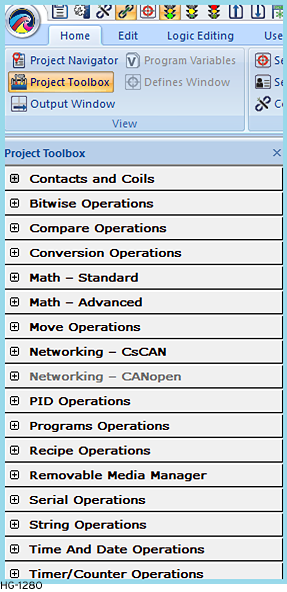Project Toolbox for Advanced Ladder 
See also: Advanced Ladder Logic Programming
The Project Toolbox contains all elements needed to build a Cscape program.
Home > View> Project Toolbox

The logic elements can be placed in the logic editing area in the following ways:
-
Drag – Drop Mode: The selected element can be dragged and dropped in the logic editing area.
-
Element Selection Mode: After selection of the logic element, the mouse pointer will be changed to the selected element when moved to logic editing area. On clicking the selected element will be placed in the logic editing area and allows placing of same logic element multiple times until the element is de-selected, or until the ‘Esc’ key is pressed.
Project Toolbox Contents in Advanced Ladder
|
Type |
Description |
|---|---|
| Alarm Handling in Advanced Ladder | The alarm handling function block provides automatic display screen selection based on the current state of one or more alarms. |
| Bit Set, Bit Clear, Bit Test in Advanced Ladder | The Bit Set function sets a single bit high in a long string of bits. The string of bits may be many Words in length. |
| Bitwise in Advanced Ladder | The Bitwise Operations are a group of functions that allow manipulation of data at the bit level. They are operations that are performed on bit patterns rather than values. They are specified to operate on either a WORD |
| Compare in Advanced Ladder | The Compare Operations act as conditions for a rung of ladder logic, like contacts but for values instead of bits. If the comparison is TRUE, then power can pass through the function and on down the ladder rung. If the comparison is FALSE, power cannot pass through. |
| Contacts and Coils in Advanced Ladder |
The Contacts and Coils operations are the simplest Ladder Logic functions and consists of Contacts and Coils. |
| Conversion in Advanced Ladder | The conversion operations in Cscape are used to translate data from one format to another. The result is always the same value but in a different data format. |
| Counters in Advanced Ladder | A counter is a function block that counts up or down until it reaches a limit. When the limit is reached the output is set. |
| Limit in Advanced Ladder | The limit function combines a multiple comparisons into a single function and checks a value to be inside or outside a range of values. |
| Math - Standard in Advanced Ladder | The Math functions allow for basic math operations as well as more advanced operations. These functions default to INT |
| Math - Advanced in Advanced Ladder | The Advanced Math functions allow for math operations beyond the basic Multiplication / Division / Addition / Subtraction functions. Many times, these functions will result in an outcome that is a fraction of 1. Therefore, they are all (except the Scale function) only available on variables/registers in REAL or LREAL format. |
| Move in Advanced Ladder | The Move Operations allow data values to be copied or moved from one place to another in variables or arrays or registers. They are useful for initializing values at run time or capturing the state of values during a process, among other things. |
| CANOpen Ladder Elements | CANOpen ladder elements provide a way to communicate CANOpen protocol via program logic. |
| PID in Advanced Ladder | PID stands for Proportional, Integral, Derivative. PID control provides a continuous variation of output within a control loop feedback mechanism to accurately control the process, removing oscillation and increasing process efficiency. |
| Program in Advanced Ladder | Includes Move Stepper, PID, Labels, Jumps, Subroutine, Set OCS Time/Date, Alarm Handling, Remote Function Key, Recipes, and Set CAN ID. |
| Recipe in Advanced Ladder | The Load recipe ladder block loads set of OCS registers from the recipe data present on Removable Media. |
| Remote Function Key in Advanced Ladder | Press Key ladder block provides a facility to add 'Replicate Key' to existing Function keys, soft keys, and other front panel keys of the OCS. |
| Remote I/O in Advanced Ladder | The Networking CsCAN Operations provide a way to communicate via program logic. |
| Removable Media in Advanced Ladder | Includes Read, Write, Rename, Delete, and Copy. |
| Serial Communication in Advanced Ladder |
Serials Operations provide a way to communicate via program logic. |
| String in Advanced Ladder | Includes Move, Compare and Measure. |
| Time and Date in Advanced Ladder | Includes Time of Day, Week, Month, and Year. |
| Timer in Advanced Ladder |
A timer is a PLC instruction measuring the amount of time elapsed following an event. Timer instructions come in two basic types: on-delay timers and off-delay timers. A counter is a PLC instruction that either increments (counts up) or decrements (counts down) an integer number value when prompted by the transition of a bit from 0 to 1 (“false” to “true”). |
| Words and Heartbeats in Advanced Ladder | The Get Network Words function, aka Net Get, is used to retrieve data from the Horner CsCAN bus, data which would have been broadcast to the CsCAN bus using the Put Network Words function in other OCS controllers. |